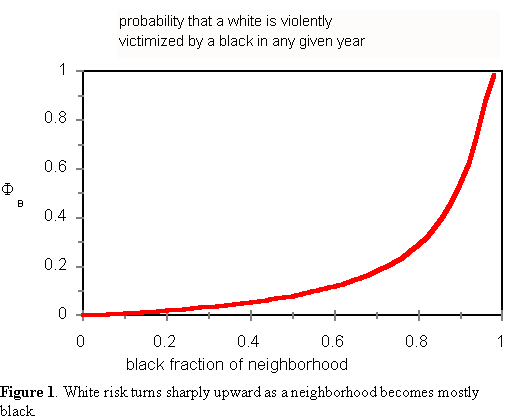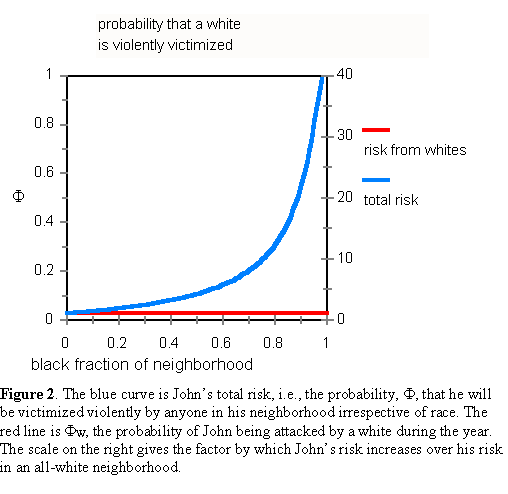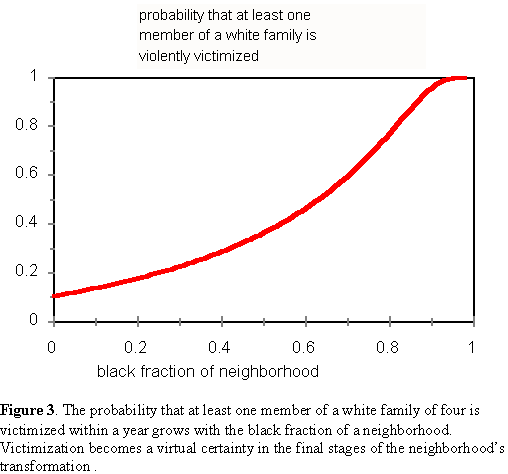|
|
A crisis of
violence
In John's city, neighborhoods do not integrate, they go black. He has seen it happen elsewhere. He knows what to expect. John and his family will soon face intolerable hardships. They will have to move. Inevitably the last whites able to leave, will. High among their reasons will be fear -- fear of becoming victims of violent crime. As his neighborhood turns black, John and his family will notice many changes, but none will be more dreaded than the prospect of being violently victimized. We will model violent crime in John's
neighborhood, tracing its evolution as the community goes from all white
to all black. We will chart the course of victimization from insidious
beginnings to the threshold of intolerability. We will show that initially
the swelling danger will be barely noticeable, but from the beginning there
will be an underlying acceleration that ultimately will drive the risk
to extreme levels.
The data
The best and most complete evidence comes from the Justice Department. Its annual National Crime Victimization Survey (NCVS) canvasses a representative sample of about 80,000 Americans, from roughly 43,000 households. From this survey, a picture of crime is painted by its victims. The last full report of the NCVS was issued in 1994. From it we learn that blacks committed 1,600,951 violent crimes against whites. In the same year, whites committed 165,345 such offenses against blacks. Despite being only 13 percent of the population, blacks committed more than 90 percent of the violent interracial crime. Less than 15 percent of these had robbery as a motive. The rest were assaults and rapes. The asymmetry of interracial crime
goes still deeper. More than half the violence committed by blacks is directed
against whites, 57 percent in 1994. Less than 3 percent of the violence
committed by whites is directed against blacks. Population and NCVS statistics
reveal that in 1994 a black was 64 times more likely to attack a white
than vice versa. In the city, the races live mostly apart from one another,
so that the most convenient victims of thugs are others of the same race.
Only a hunter's mentality could account for the data. Given a choice, a
black thug will select a white victim. Ironically, so will a white thug.
Modeling the Hood
Divide the number of criminally violent victimizations perpetrated by blacks in a year, by the black population and call this quantity, pB. It is related, but not equal, to the probability that a randomly selected black is a violent criminal. It would be that probability if criminals always acted alone and committed only one violent act per year. Since we are interested in victimization, pB is the more relevant quantity. The corresponding quantity for whites is pW. The probabilities calculated below
refer to a one-year period. First we look at the probability, ΦB,
that a particular white, say John, will be victimized at least once by
blacks. The white population in the hood is NfW. Consistent
with NCVS data, we assume that if presented with a convenient choice, both
black and white thugs will select white victims over black. Then, the number of
incidents involving white victims and black perpetrators is pBfBN.
For simplicity, we assume single-victim incidents. (This does not preclude
victims from being attacked more than once a year.) The probability that
John will be the victim in Incident 1 is 1/(NfW). The
probability that John will not be that victim is 1-1/(NfW).
The probability that John will not be the victim of Incident 2 is also
1-1/(NfW). If each incident is independent of the others,
the probability that John will not be victimized by blacks this year is
(1-1/(NfW))^(pBfBN). The
probability that John will be victimized within the year is then
 (1)
(1) The probability, ΦB,
may be conveniently approximated when NfW >> 1, a condition
met in every practical circumstance. The approximation will be seen to
hold over the useful range of the function. It may be obtained by noting
that the second term on the right hand side of (1) is of the form (1 -
ε)^n, where ε
<< 1. If y = (1 - ε)^n,
we may write ln y = nln(1 - ε).
For small ε, ln(1 - ε)
≅ -ε (the linear
term in the expansion about ε = 0), so that
ln y ≅ -nε.
Exponentiation gives back the approximation, (1 - ε)^n
≅ exp(-nε).
Accordingly, we write for ΦB
 (2)
(2) The approximation (2) is attractive
because it has no explicit N dependence. To a high degree of approximation,
the size of John's neighborhood will not change the likelihood of him becoming
a victim. For N = 1000 and pB = 0.0858 (estimated
from the NCVS below), we computed ΦB
from (1) for various black neighborhood fractions, fB.
For the same value of pB, we also applied the approximation
(2). The results are compared in the table below. Agreement is excellent
throughout the range of racial composition.
To use either (1) or (2), we need the quantity, pB. It may be estimated from NCVS data. In 1994, blacks committed 2,802,538 violent crimes. The Census Bureau puts the black population as of July 1, 1994 at 32.653 million. The ratio of offenses to population gives us the value: pB = 0.0858. Results
 Risk from whites
Regardless of the state of racial
mixing, the number of victimizations per year perpetrated by whites in
the hood is given by pWfWN. The probability
that John will be the victim of white-on-white Incident 1 is 1/(NfW).
The probability that John is not that victim is 1-1/(NfW).
The probability that John is not the victim of Incident 2 is also 1-1/(NfW).
Again, assuming independent incidents, the probability that John is not
victimized by a white in the given year is (1-1/(NfW))^(pWfWN),
and the probability, ΦW, that
John is victimized by whites is
 (3)
(3)The probability, ΦW, may be approximated by similar methods used to approximate ΦB, giving ΦW ≅ 1 - exp(-pW). We can make a further simplification here. Since pW << 1, we may write exp(-pW) ≅ 1 - pW, giving us the extraordinarily simple expression:
 (4)
(4) Equation (4) gives the probability
that John will be victimized by a white in a given year. It shows that
to a high degree of approximation, the risk John faces from whites is not
only independent of neighborhood size, but also neighborhood composition.
The probability that John is attacked by whites in a given year is the
same no matter where he lives. It is simply equal to the per capita number
of violent incidents perpetrated by whites in a year. We tested this approximation,
setting N = 1000 and pW = 0.0279, the value obtained
from the NCVS. Over most of the range of racial composition, the approximation,
ΦW = pW
= 0.0279 agrees within 2 figures with the accurate expression (3) as seen
in the table below.
We note that John's risk from whites remains a bit under 3 percent from the day the first black moves into his neighborhood until the last white leaves. Total risk
 (5)
(5)In Figure 2, we plot the probability, (in blue) that John is violently victimized by anyone from his neighborhood, irrespective of race during the year. Also shown (in red) is John's risk from white thugs. Because John knew crime before his neighborhood began to turn black, we are also interested in comparing his post-integration risk with his pre-integration risk. The scale on the right side of Figure 2 shows the factor, Φ/ΦW, by which John's risk has increased since blacks moved into his neighborhood.
 The probability that at least one member of John's family will be violently victimized in any one year is simply 1-(1-Φ)4. Figure 3 shows how this probability varies with the neighborhood's racial composition. In a 50 percent black neighborhood, there is a 37 chance that John's family will in some way be violently victimized. As the neighborhood relentlessly turns black, some whites will have to be among the last to leave. If John is unfortunate enough to be one them, he will face the following statistics: When the neighborhood is 90 percent black, John and his family will have a 96 percent chance of being victimized. Soon after that victimization will become a virtual certainty, reaching 99 percent likely when the neighborhood turns 93 percent black.

Summary
|
|